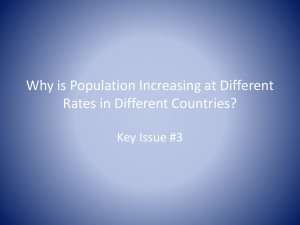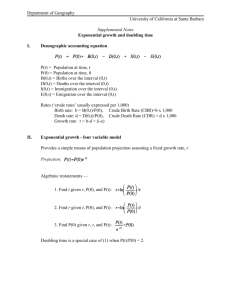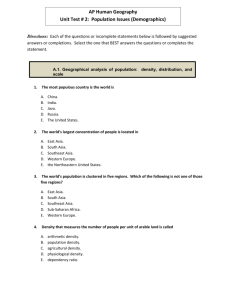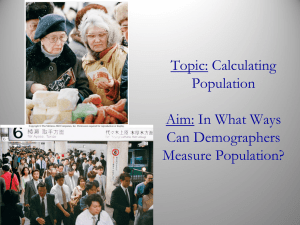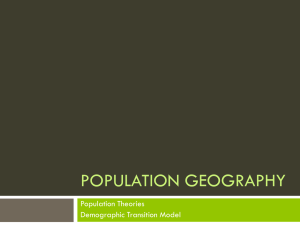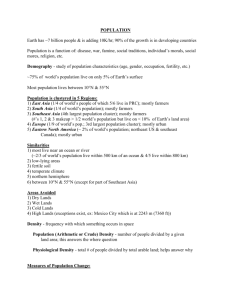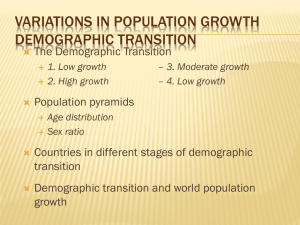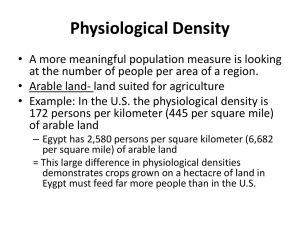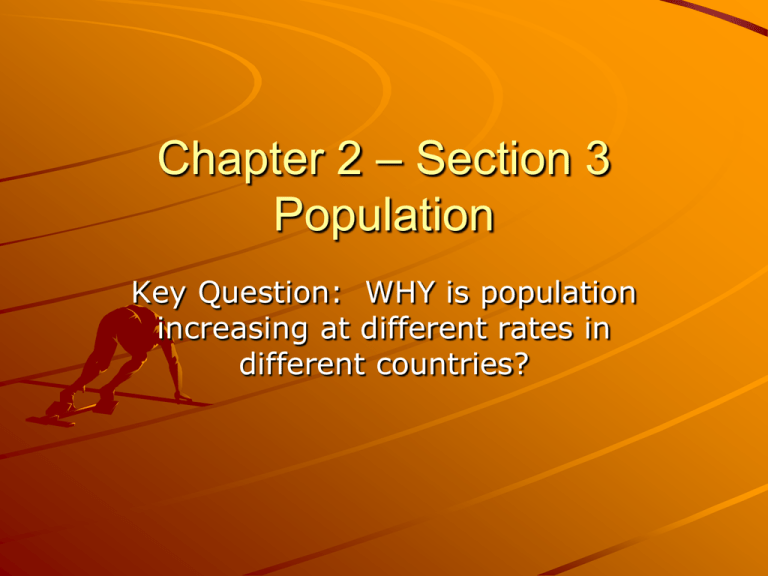
Chapter 2 – Section 3
Population
Key Question: WHY is population
increasing at different rates in
different countries?
First, Let see what you
remember!
Number your paper 1-5 in the
margin!
1) Which of the following
countries would have the lowest
arithmetic density?
A) Russia
B) Japan
C) The Netherlands
D) Haiti
2) What is the difference
between Population and
Physiological Densities
A) Population Density looks at
difference races and ethnicities.
B) Physiological Density can be used
to tell if a country is an LDC or MDC.
C) Population Density is concerned
only with the population of farmers.
D) Physiological Density is only
concerned with arable land.
3) All of the following acronyms
can be used to determine if a
country is an LDC or an MDC
EXCEPT:
A) NIR
B) IMR
C) CDR
D) TFR
4) The higher the NIR…
A) the shorter the doubling time.
B) the lower the CBR
C) the longer the life expectancy
D) the fewer the number of children
5) A country with a very low
agricultural density has
A) a high amount of farmers per acre
of arable land.
B) a very small population
C) a lot of available technology
D) very little arable land
Let’s see
how you
did!
1) Which of the following
countries would have the lowest
arithmetic density?
A) Russia
B) Japan
C) The Netherlands
D) Haiti
2) What is the difference
between Population and
Physiological Densities
A) Population Density looks at
difference races and ethnicities.
B) Physiological Density can be used
to tell if a country is an LDC or MDC.
C) Population Density is concerned
only with the population of farmers.
D) Physiological Density is only
concerned with arable land.
3) All of the following acronyms
can be used to determine if a
country is an LDC or an MDC
EXCEPT:
A) NIR
B) IMR
C) CDR
D) TFR
4) The higher the NIR…
A) the shorter the doubling time.
B) the lower the CBR
C) the longer the life expectancy
D) the fewer the number of children
5) A country with a very low
agricultural density has
A) a high amount of farmers per acre
of arable land.
B) a very small population
C) a lot of available technology
D) very little arable land
Isn’t it exciting
class! Today,
we’re going to
learn the
Demographic
Transition!
I. The Demographic
Transition
A) Stage 1:Low Growth
AKA:
Hunting & Gathering
Pre-Modern
Pre-Industrial
1)Most of Human
History*
2) CBR = *
3) CDR = *
4) NIR = *
0
5) 1st
Agricultural
Revolution*
6)
*
B) Stage 2 – HIGH Growth
1 – CBR*
2 – CDR*
3) NIR*
4) Why did population increase
in Stage 2 countries?
200 years ago?*
60 years ago?*
5) Industrial Revolution lowered
CDR by
-increased wealth*
-sanitation*
nd
-2 agricultural
revolution*
But only for Europe and
North America!
6) Medical Revolution (Asia,
Africa, South America)
Medical Revolution
Examples:
Vaccinations*
Medicine*
Cape Verde*
Diffusion of Med. Rev.*
Medical Revolution
C) Stage 3: Moderate Growth
AKA: Mature Industrial/Late Indus.
1 -CDR*
2 -CBR*
3 -NIR*
4) Europe and North America*
5) Why did CBR decrease?
Lower IMR*
Cities*
Chile*
D) Stage 4: Low Growth
AKA Tertiary (service-based)
Societies
Post-Industrial Stage
1-CBR/CDR*
2-NIR*
3-TFR (ZPG)*
4) Why does the CBR drop so
low?
Contraceptives
Contraceptives
Education of Women*
More
Choices
5) Denmark
E) The “S” Curve
F) 2 Differences between Stage 1
and Stage 4 (Both LOW growth)
What’s the Difference????
1- CBR/CDR
2 – Total Population
G) Stage 5: Declining
Population
1 –Possible Stage*
CBR*
CDR*
2 –Eastern Europe
(Russia)*
3 – Japan*
(Page 65)
2-3 Population Pyramids
NOT :
Population Pyramids
This is what they REALLY look like:
II. Population Pyramids
A) Age Distribution
B) Sex Ratio
C) CBR
http://www.geogonline.org.uk/as_g2
ki1.51.htm
China’s population change (go to
website)
D) Dependency Ratio
Measures
–Too old & Too Young
–Productive Workers
LDC’s have
High
Dependency
Ratios!
THE
END
Teacher Note:
Reading/Notes:
Spatial Analysis
and the Census
(pg 62)



